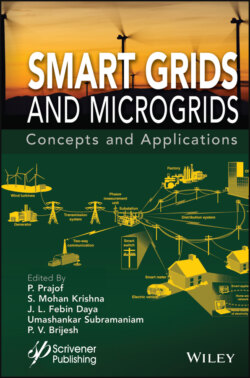Читать книгу Smart Grids and Micro-Grids - Umashankar Subramaniam - Страница 45
2.5.2 DC-AC VSI Interfacing AC-Microgrid
ОглавлениеDepending on microgrid structure, grid-tied inverter interfaces the ESS (Energy Storage Systems) to the external ac gird or the ac bus of ac microgrid. Generally, 3-phase VSI based converter is used and a typical schematic is shown in Figure 2.7. The converter and its associated controller is supposed to perform the following functions:
a. If the system is in grid-connected mode, the VSI is supposed to supply real and reactive power to the grid. In case the ESS is discharged, ac power has to be absorbed from the grid to charge the ESS.
b. In islanded mode, the ESS is required to maintain the PCC voltage to the reference voltage.
Figure 2.5 Waveforms under the condition when battery-converter system is connected to microgrid.
Figure 2.6 Waveforms under the condition when battery-converter system is in islanded mode.
Figure 2.7 Three-phase inverter interfacing battery to grid.
Figure 2.8 Controller for inverter interfacing battery to grid.
In order to address the above requirements, the controller should have a provision to work under the mode dictated by EMS. One typical configuration of such a controller is shown in Figure 2.8. For an AC system, the variables to be regulated are a sinusoidal function of time and hence the closed-loop control system must have a sufficiently large bandwidth for tracking the variables. To transform variables to dc quantities for achieving zero steady-state error by using a PI controller and decoupling the regulation of real power and reactive power, the converter is controlled in the synchronous frame (d-q) [14].
When Modecommand = 1 (the converter is in grid-connected mode), the battery is supposed to supply active or reactive power to the grid. The reference power (Pref, Qref) that has to be supplied by the battery-converter system is obtained from the energy management system of the microgrid. The instantaneous active (P) and reactive powers (Q) supplied by the converter system can be expressed in a d-q frame as
(2.17)
(2.18)
Where Vs, id, and iq are PCC voltage on d-axis, output current on d-axis, and output current on q-axis, respectively. As the grid-connected converter act as current source, the reference grid current (id(ref), iq(ref)) to be fed can be obtained using relation
(2.19)
(2.20)
The inner current loop is designed to track the reference current (id(ref), iq(ref)) and it generates the PWM gating signal for switches of the converter. The current loop needs angle ρ ( to convert quantities from the d-q frame back to abc frame) information, which is obtained from the Phase-locked loop of the system. When the battery SOC is low, then the reference active power is negative (Pref = -ve and Qref = 0) to charge the battery.
When Modecommand = 0, the microgrid is in islanded mode and the voltage at PCC has to be regulated to a reference voltage. The battery is supposed to supply active or reactive power to the grid to maintain the PCC voltage. The current reference ( (id(ref), iq(ref)) is obtained from an outer voltage loop. The outer voltage loop ensures that the PCC voltage is maintained at its reference value. The modeling of the converter and design of the controller under different modes is discussed in the next section.
